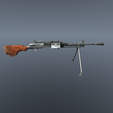After the end of World War 1. In the design office of the Kovrov factory, under the leadership of Fedorov and his student Degtyarev, experimental work was carried out on the family of 6.5 mm automatic weapons.
Within this family, several variants of light, heavy, aircraft and tank machine guns with different barrel cooling and power supply schemes were developed. However, none of the Fedorov-Degtyaryov rifles were accepted for mass production.
Degtyarev at the end of 1923 began to develop his own model of a light machine gun. He took as a basis the design of his own automatic rifle, which he proposed in 1915. Then, combining known patterns, he obtained a compact system that received a positive review from Fedorov. On July 22, 1924, Degtyarev presented the first prototype of a disk magazine machine gun that he had developed for the Fedorov-Degtyaryov joint machine gun projects.
The magazine was designed for the 6.5 mm cartridge and had a capacity of 50 rounds. At this point in the project, it was decided to change the ammunition to 7.62x54R, but having already prepared the magazine diagram, it was decided to simply modernize it. Originally, the magazine held 49 rounds. Because the spring force was not enough to power the last cartridges, its capacity was changed to 47.
Degtyarev presented the next prototype in the fall of 1926. About five thousand shots were fired from two copies and it was found that the ejector and firing pin were not strong enough, and the weapon itself was sensitive to dust. In December, two more machine guns were tested in unfavorable shooting conditions, but they were also returned for inspection. At the same time, an improved Maxim-Tokarev model was tested, as well as the German Dreyse.
Degtyarev was superior to these structures, which then aroused great interest among the leadership of the Red Army. Despite this, Degtyarev had to make a number of changes to its design. Two modified Degtyarev machine guns were tested by the commission on January 17–21, 1927, and the machine guns were found to have "passed the test". On February 20, the same Commission, without waiting for the results of the improvements, decided to issue an order for 100 machine guns.
The first batch of 10 machine guns was presented for military acceptance on November 12, 1927. The army received the entire batch of 100 machine guns on January 3, 1928. On January 11, the Revolutionary Military Council ordered the transfer of 60 machine guns for military tests. Based on the results, it was recommended to add a flame arrester. In addition, a number of other comments were submitted. In August 1928, an improved model was tested. An order was placed for 2.5 thousand machine guns. At the end of 1928, a decision was made to discontinue the production of MT (Maxim-Tokarev) machine guns. As a result, the Degtyarev light machine gun ended up in the Red Army. The machine gun was adopted under the designation "7.62 mm light machine gun of the Degtyaryov system, model 1927". or DP-27 (Degtyarov Pekhotnyy 1927). The Degtyarev machine gun became the first mass-produced machine gun developed in the country.
Note 1: Different sources are may designate the DP as DP-27 or as DP-28; this confusion arose because the DP was accepted by the Russian military in 1927, but production started in 1928.
I have set them to a 1:35/1:72 ratio for easy printing, and the size comes from the data provided by the encyclopedia. You can adjust its size to any place by yourself.
Note: If using the model for 3D printing, model repairs may be needed.


















